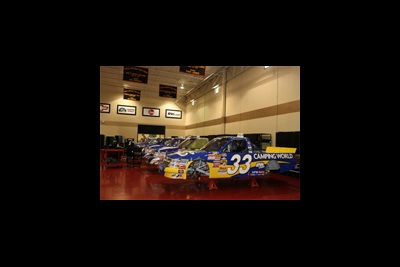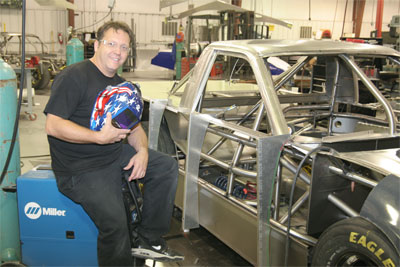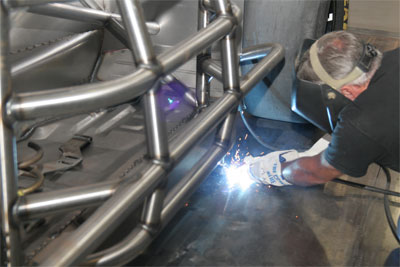Beefed up spindles, roll cages & precision bodywork
Punishment. At 200 mph, it’s the best way to describe the beating that multiple left-handed turns can put on a car or truck. Then there’s the competition to keep a close eye on as drivers aggressively fight for the lead. Team Fabricators with Kevin Harvick Inc. (KHI) know a thing or two about punishment as they teardown, and rebuild the trucks and cars that Harvick races in NASCAR’s Camping World Truck Series and Nationwide Series. The speed and g-forces placed on these cars and trucks is tremendous – but they’re nothing when compared to the energy the vehicles must absorb if they collide with the wall or take a 180 mph (unintentional) shot from another racer. In these cases, NASCAR drivers place their safety, even their lives, on their vehicles’ integrated safety measures and also on the structural toughness of their cars and trucks. Since no metal-to-metal bond is stronger than fusion, MIG and TIG welding techniques are essential among NASCAR team fabricators.
 |
|
Kevin Harvick Inc.’s Camping World Series trucks are built for structural endurance. Crew fabricators apply several key MIG and TIG welding techniques to increase driver safety and their competitive edge.
|
Harvick’s highly skilled fabricators employ a variety of welding processes in the construction and repair of the racing team’s Nationwide Series cars and Camping World Series trucks. The essential welding jobs include exhaust installation; Chassis and roll cage, body panel and bed top construction, rocker panel installation and manufacturing major suspension components.
NASCAR rules enforce standardization of many truck and car physical characteristics and components, including vehicle shape, length and girth, in addition to how parts must be assembled. NASCAR also mandates integration of innumerable safety features.
Crucial spindle is hardened for battle
Among the most vulnerable components of a NASCAR race vehicle are the wheel spindles. The spindle ties the control arms, ball joints, springs and steering system together, and typically is a forged metal component. It has fittings to mount the ball joints at bottom and top, and in the middle the spindle is equipped with an axle hub, to which the wheel and its bearings are attached. The spindle also has a fitting to mount the steering components (i.e., steering arm).
According to NASCAR rules, each front spindle must be bolted to the lower steering arms. KHI crews comply, saving weight by using gun-drilled bolts. However, team fabricators take an extra step to reinforce the attachment of the front spindle to the steering arm by also TIG welding them together.
“These cars can get hit pretty hard,” says Donald Colwell, fabricator and tire changer on the 33 Nationwide car. “You take a wheel shot in a wreck and a lot of time those bolts will crack or break, so welding the spindle and steering arm can help prevent what might otherwise be a catastrophic failure.”
Colwell adds that welding on metal brackets further strengthens the spindle or “gussets,” which makes the spindle assembly more rigid and able to absorb more energy from an impact.
 |
|
| Side gussets are welded onto the sides of the front spindles for extra impact-absorbing reinforcement. |
|
TIG welding is preferred over MIG because of the spindle’s material, up to 1-in. thick 4140 chrome-moly, for which TIG provides a much smoother arc transfer and better fusion.
The material deposition – how big the weld bead is – is also much smaller with TIG and more precise. For example, when you’re welding on the brake caliper brackets, they have to be in perfect alignment with the rotor – otherwise the brakes are going to wear unevenly. This will result in brake fade and the calipers could seize up if they’re not perfectly in line with the rotors. The need to TIG weld is all about precision and strength.
For TIG welding, the KHI crew uses Miller Electric Mfg. Co.’s Syncrowave 250 DX. This machine produces dramatically better arc starts through its selectable (soft, standard or hot) start condition feature. Hot start improves starts with the larger diameter tungsten used for welding thicker materials, such as the wheel spindles.
KHI’s crew uses 3/32-in. high tensile strength filler rod that is a blended stainless steel alloy. The amperage set at 200 but is varied by the remote foot control. Before any welding can take place, however, crewmembers pre-heat the spindle at 500? F for three hours in an industrial oven. This is done to prevent weld cracking associated with more rapid cooling of thick base metal in relation to the cooling rate of the filler metal.
Unheated, thick base metal will cool rapidly; causing contraction that will rip and tear the filler metal apart. When the spindle in the oven turns a purplish tint, which means it has been pre-heated enough to weld.
Team fabricators use a Weldcraft WP-225 Modular Flexible Neck Torch. The 25 ft. 250-amp water-cooled torch with a gas lens and small No. 6 cup, enables them to use a 1/2-in. electrode stick-out to close in on the weld bead and improve joint access. This particular torch has a flex head feature and a quick disconnect head, allowing fabricators to change out the heads for numerous TIG welding applications, solving the problem of difficult space and welding positions.
An air-cooled torch for this application would be so big it would not be feasible. The consumables would have to be so large to keep the torch from burning up.
 |
|
Stacked dime appearance of TIG weld beads on spindle-steering arm unit.
|
The roll cage: The NASCAR driver’s best friend
Tubular steel of varying thicknesses is the most critical component of any NASCAR vehicle, as it forms the roll cage – a metal tube skeleton over which the vehicle’s sheet metal skin is attached. The roll cage – composed of .090 wall, 1.75 diameter tubing – is included in the car or truck’s middle section and is designed to be tough enough to maintain its integrity during a crash, thus shielding the driver from harm. The roll cage is sandwiched between the front and rear sections or “clips,” which are fabricated from .120 wall steel tubing and designed so that they will crush when the vehicle hits another car or a wall; collapsibility drains a great deal of impact energy during a crash. Interestingly, the front clip also is constructed to shove the engine out of the bottom of the car or truck – rather than into the driver’s seat – during an accident.
KHI crews MIG weld their own roll cages using the Millermatic 212 (210 amps at 30% duty cycle), an all-in-one MIG welder for mild steel welding applications.
Roll cage tubing thicknesses vary from 120-wall frame rails to the 90-95-wall tubing down to 62-wall. The settings are typically anywhere from 3- to 50- or 4- to 50- on the voltage/wirefeed adjustment.
 |
|
The body’s sheet metal skin fits underneath the area provided by the tack-welded templates.
|
NASCAR Bodies Thin-skinned but Tough
Fabricating the sheet metal body for a NASCAR racer is a painstaking process, taking a shop 10 working days to create and install the body for just one car or truck. The vehicle shape is determined primarily by NASCAR rules, which are inherent in 30 templates, each shaped to conform to the various curves of the car. This is known as the “Car of Today” template. The largest, for example, fits over the car’s center from rear to front. When this template is lowered onto the frame, the gap between the template and the vehicle cannot go over a certain tolerance.
Some panels are pre-made and supplied by the car/truck manufacturer, (e.gs., roof, hood and deck lid), while those in between templates are fashioned using an English wheel. This device enables hand rolling of trimmed, flat sheet metal by slowly bending and curving panel segments until their contours conform to the templates and fit over the roll cage and front and rear clips.
 |
|
Gene Dehart, crew fabricator, Kevin Harvick Inc., is shown here tack-welding a NASCAR template member to Camping World Series truck’s passenger compartment rocker panel.
|
The next step is to weld the shaped panel segments to the car and to each other. KHI maintenance personnel accomplish this task with the Millermatic 212. ”The fast arc starts possible on this welder are critical considering the thinness of the .024-in sheet metal skin and the tack welding application,” states Gene Dehart, crew fabricator, Kevin Harvick Inc.
“In racing, a lot of the welding we do are tack or stitch welds,” he says. “And the fast arc starts are so crucial because you’re on and off the trigger so much with this type of welding. If we weren’t able to achieve fast arc starts with the thinness of the material we’re working on, you either punch a hole through it or don’t get sufficient penetration.”
The tack welds are spaced about every two to three inches on the panel seams and then ground down to blend into one smooth, seamless piece. The final step before hitting the track is priming and painting.